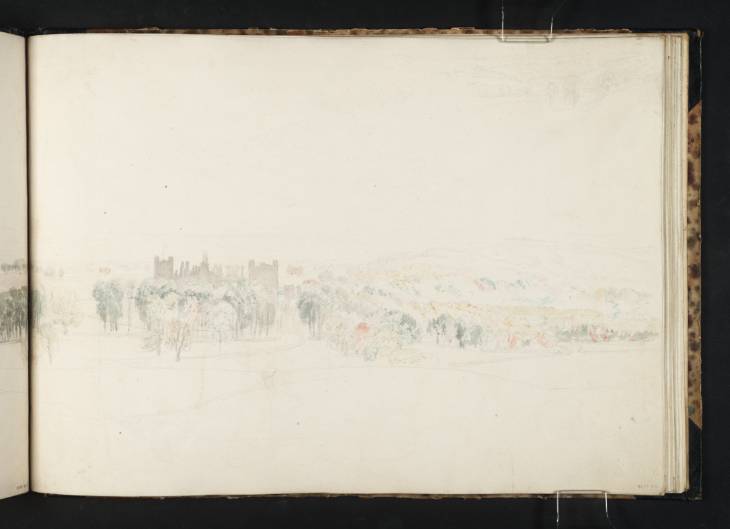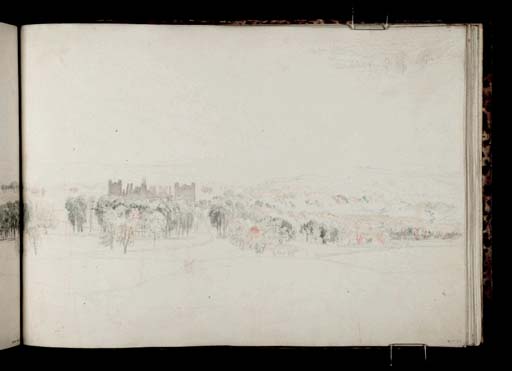Joseph Mallord William Turner Raby Castle and Park from the North 1817
Image 1 of 2
Joseph Mallord William Turner,
Raby Castle and Park from the North
1817
Joseph Mallord William Turner 1775–1851
Folio 20 Verso:
Raby Castle and Park from the North 1817
D12301
Turner Bequest CLVI 24
Turner Bequest CLVI 24
Pencil and watercolour on white wove paper, 232 x 328 mm
Inscribed by Turner in pencil ‘R’ in trees right of centre
Stamped in black ‘CLVI 24’ bottom right
Inscribed by Turner in pencil ‘R’ in trees right of centre
Stamped in black ‘CLVI 24’ bottom right
Accepted by the nation as part of the Turner Bequest 1856
Exhibition history
1878
Oxford Loan Collection, University Galleries, Oxford 1878–1909 or later (90; renumbered 92a).
1974
Turner 1775–1851, Royal Academy, London, November 1974–March 1975 (202).
1983
J.M.W. Turner, à l’occasion du cinquantième anniversaire du British Council, Galeries nationales du Grand Palais, Paris, October 1983–January 1984 (132, reproduced).
1987
Watercolours from the Turner Bequest, Tate Gallery, London, April–October 1987 (no catalogue).
1990
The Third Decade: Turner Watercolours 1810–1820, Tate Gallery, London, January–April 1990 (52, reproduced).
References
1904
E.T. Cook and Alexander Wedderburn eds., Library Edition: The Works of John Ruskin: Volume XIII: Turner: The Harbours of England; Catalogues and Notes, London 1904, p.564 (Oxford loans catalogue, 1878) no.92[a], as ‘Raby. Autumnal colouring’.
1909
A.J. Finberg, A Complete Inventory of the Drawings of the Turner Bequest, London 1909, vol.I, p.448, CLVI 24, as ‘Raby Castle’.
1969
John Gage, Colour in Turner: Poetry and Truth, London 1969, pp.40, 111, 232 note 111, 250 note 189.
1974
Gerald Wilkinson, The Sketches of Turner, R.A. 1802–20: Genius of the Romantic, London 1974, reproduced p.169 (colour).
1977
Gerald Wilkinson, Turner Sketches 1789–1820, London 1977, reproduced p.145 (colour).
1979
Andrew Wilton, J.M.W. Turner: His Life and Work, Fribourg 1979, p.172 note 28.
1983
Andrew Wilton, in John Gage, Jerrold Ziff, Nicholas Alfrey and others, J.M.W. Turner, à l’occasion du cinquantième anniversaire du British Council, exhibition catalogue, Galeries nationales du Grand Palais, Paris 1983, pp.[208]–9 no.132, reproduced.
1984
Martin Butlin and Evelyn Joll, The Paintings of J.M.W. Turner, revised ed., New Haven and London 1984, p.101 under no.136.
1990
Diane Perkins, The Third Decade: Turner Watercolours 1810–1820, exhibition catalogue, Tate Gallery, London 1990, p.44 no.52, reproduced.
2002
David Blayney Brown, Turner in the Tate Collection, London 2002, reproduced pl.57 (colour).
The composition continues on folio 21 recto opposite (D12300; CLVI 23a). The overall view is similar to that on folios 19 recto, 18 recto and 17 verso (D12278, D12296, D12297; CLVI 11a, 21a–22). Here the castle is seen contre-jour to the south, in an effect replicated in his painting Raby Castle, the Seat of the Earl of Darlington, exhibited at the Royal Academy in 1818 (Walters Art Gallery, Baltimore),1 although the overall composition was taken from folios 18 recto–17 verso,2 where the viewpoint is a little higher and to the east.
The outlines of Bulmer’s Tower, the chimney of the Kitchen Tower and Clifford’s Tower run from the left, with the twin turrets of the gatehouse to the north-east just visible below to the right. The viewpoint is below that of the three-part panorama, with the lower storeys lost behind the trees. Stables and other outbuildings are screened by the trees on the right, where a blue squiggle probably indicates smoke. The road running known to the castle gate turns and continues east to the North Lodge gatehouses, visible in the other half of the drawing.
Technical notes:
This may be a rare instance of Turner applying colour while actually sketching (or possibly later, guided by his tonal pencil hatching). The colours across a band in the middle distance are soft tones of grey, grey-green, yellow or ochre, red and blue, with the grey confined to flat washes within the silhouette of the castle, and the colours applied sparingly in disjointed dabs across the foliage. The point inscribed ‘R’ has been coloured red, and there may be one or two other inscriptions too delicate to be sure of, similar to the tiny words and letters which annotate the three-part panorama in pencil alone mentioned above.
John Gage has seen the sketch as an early use by Turner of ‘prismatic’ colour, with ‘small flecks of red, blue and yellow only’,1 in his development of a sort of conceptual, proto-‘pointillism’,2 although Andrew Wilton has noted that the red and yellow can be explained by Turner’s sketching at Raby in October, when the colours of the autumn leaves would have been at their most intense.3 The foliage in the 1818 painting is fairly muted, and keyed to the silvery light of the sun breaking through cloud.
Matthew Imms
February 2010
How to cite
Matthew Imms, ‘Raby Castle and Park from the North 1817 by Joseph Mallord William Turner’, catalogue entry, February 2010, in David Blayney Brown (ed.), J.M.W. Turner: Sketchbooks, Drawings and Watercolours, Tate Research Publication, December 2012, https://www


